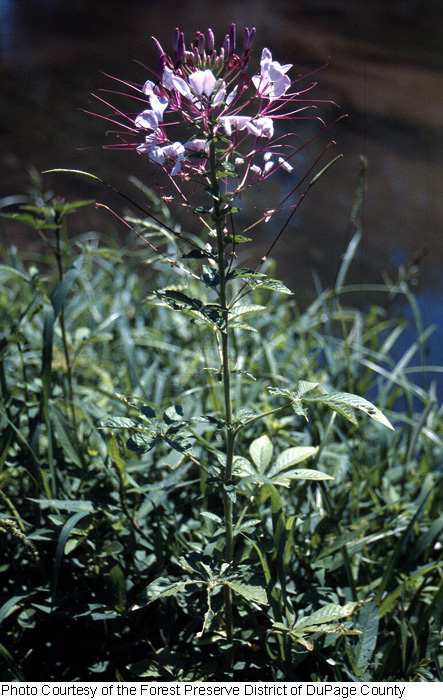|
|
|
|
Family: Cleomaceae
pink queen
[Cleome hassleriana Chod.] |
Annual herb to 1.5 m tall Stem: branching near top, covered with sticky hairs. Leaves: palmately compound with five to seven leaflets, stalked, usually having a pair of short spines at base of stalk. Flowers: borne in a terminal inflorescence (raceme), white or pink, with four sepals and six stamens. The four petals are clustered toward one side of the flower, reach 1 cm long, and narrow to a claw about 5 mm long at the base. Fruit: an elongated two-valved capsule, long-stalked, 4 - 10 cm long, with interconnecting veins, opening from base to tip, releasing kidney-shaped seeds. Leaflets: to 10 cm long, narrow and inversely egg-shaped, often finely toothed, lightly hairy. Similar species: Cleome serrulata differs by having leaves with three leaflets and more or less hairless stems. Polanisia species are distinguished by having more than six stamens, petals with a notched tip, and more or less stalkless fruit. Flowering: June to early September Habitat and ecology: This species was introduced from tropical America and rarely escapes cultivation. In the Chicago Region, it has been found growing in cracks of sidewalks and along gravelly shores of rivers. Occurence in the Chicago region: non-native Etymology: Cleome is the ancient name for a mustard-like plant. Author: The Morton Arboretum Stems to 1.5 m, branched above, viscid-pubescent; petioles commonly with a pair of short spines at the base; lfls of the main lvs 5-7, oblanceolate, finely hairy and often finely serrulate, the central one 6-10 cm; pet all oriented toward one side of the fl, white to pink, the blade obovate, 1 cm, abruptly narrowed to a claw ca half as long; fr 4-10 cm, about equaling the stipe, this nearly twice as long as the pedicel; 2n=20. Native of trop. Amer., occasionally escaped from cult. in our range, especially southward. June-Oct. (C. spinosa, misapplied) Gleason, Henry A. & Cronquist, Arthur J. 1991. Manual of vascular plants of northeastern United States and adjacent Canada. lxxv + 910 pp. ©The New York Botanical Garden. All rights reserved. Used by permission. |
|
|
|


